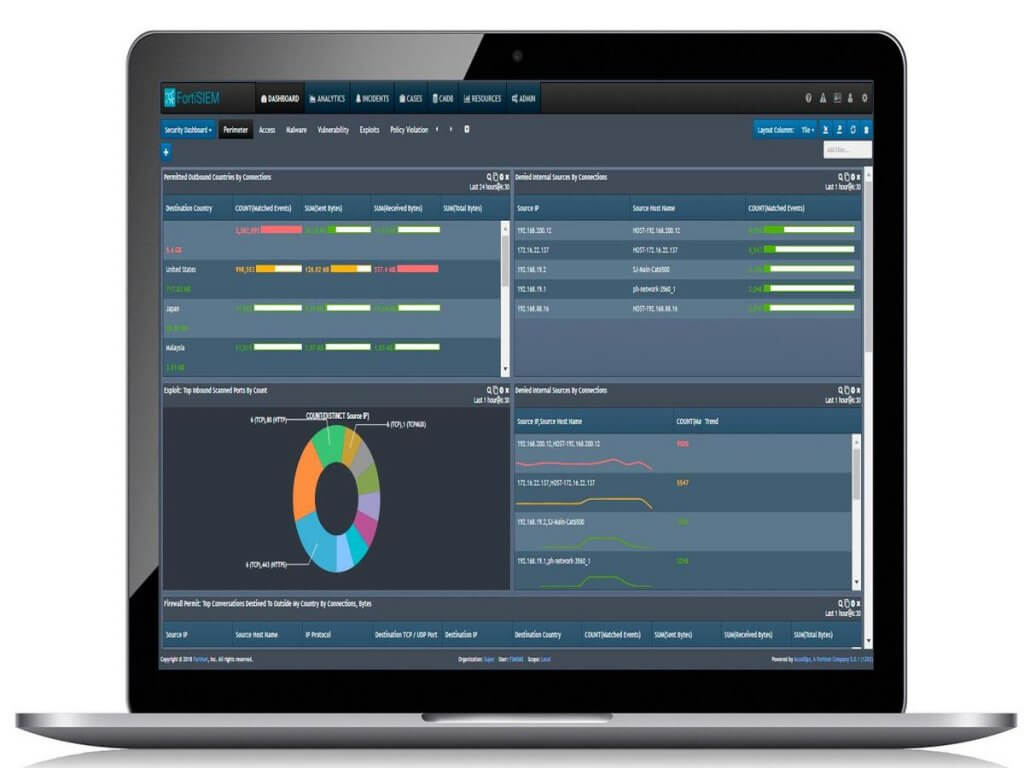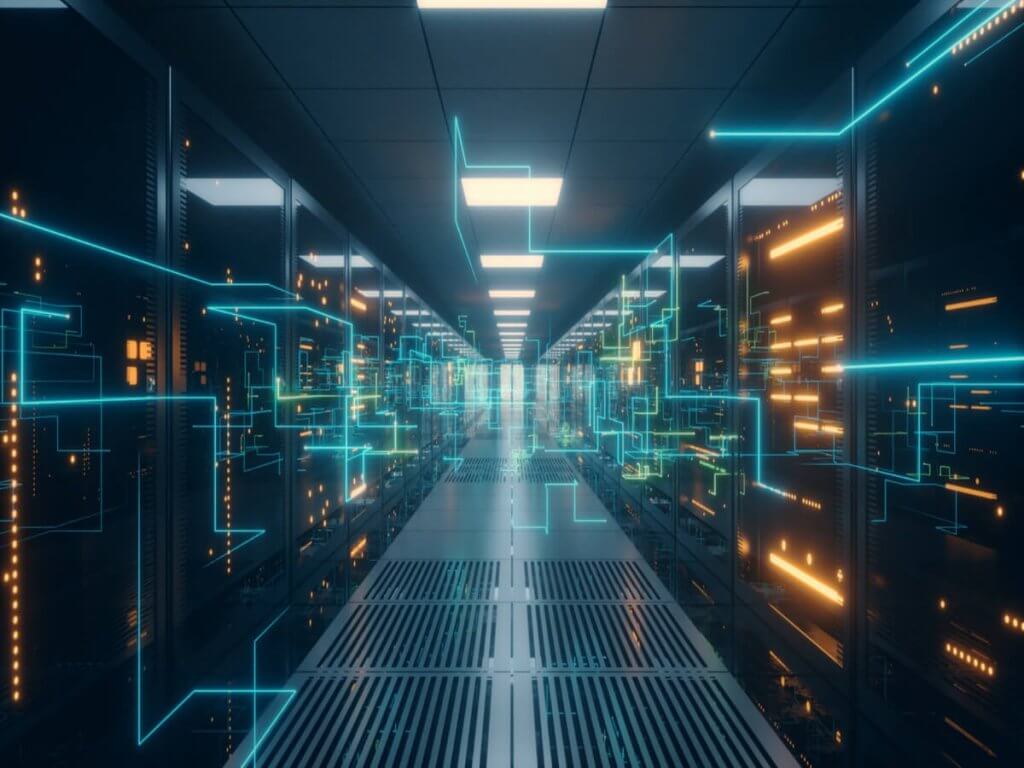FortiSIEM | Turn Data Into Insights and Insights Into Action

Image via fortinet.com
The Security Information and Event Management (SIEM) solution FortiSIEM is a highly scalable multi-tenant SIEM that offers real-time infrastructure and user awareness for precise threat detection, analysis, and reporting.
To automatically populate a Configuration Management Database, FortiSIEM first detects the infrastructure, including the devices, applications, and users in physical, virtual, on-premises, and cloud environments (CMDB). Then, it gathers and correlates a variety of data in real-time, including logs, traffic flows, performance measurements, and configuration changes, to find security and performance problems.
For data collection, primary external threat intelligence sources, major ticketing systems, and support for all essential compliance standards, FortiSIEM provides built-in connectors with over 350 devices and applications.
Read more: SIEM or Security Information and Event Management.
FortiSIEM Help Organizations Turn Data Into Insights Into Action

- Correct device context is constantly updated, including the settings, applications installed, and services running.
- System and application performance statistics are combined with contextual inter-relationship data for quick triaging of security vulnerabilities.
- Real-time user context with IP address audit trails, user identity changes, and physical and geographic location.
- Detect unauthorized network devices, hardware, software, and configuration alterations.
- Pre-defined reports are available right out of the box to support a variety of compliance auditing and management requirements, such as those for PCI-DSS, HIPAA, SOX, NERC, FISMA, ISO, GLBA, GPG13, SANS Critical Controls, COBIT, ITIL, ISO 27001, NERC, NIST800-53, NIST800-171, and NESA.
- Based on an administrator’s function, Personally Identifiable Information (PII) can be hidden to comply with GDPR standards.
- The collection of high-fidelity user-based activity, including User, Process, Device, Resource, and Behavior, is made possible by FortiSIEM Agent-based UEBA telemetry. An agent-based strategy enables the collection of telemetry while the endpoint is connected to the corporate network and when it is not, giving a more comprehensive picture of user activities. UEBA telemetry enables the detection of unknown malicious actions so that they can be warned about and remedied.
- Keep track of the fundamental system metrics.
- PowerShell, WMI, and SNMP at the system level.
- JMX, WMI, and PowerShell at the application level.
- VMware and Hyper-V virtualisation monitoring at the passenger, host, resource pool, and cluster levels.
- EMC, NetApp, Isilon, Nutanix, Nimble, and Data Domain provide storage consumption and performance monitoring.
- Monitoring specialized application performance.
- WMI and PowerShell with Microsoft Active Directory and Exchange.
- Databases using JDBC for Oracle, MS SQL, and MySQL.
- IPSLA, SNMP, and CDR/CMR VoIP infrastructure.
- Application performance and flow analysis using Netflow, SFlow, Cisco AVC, NBAR, and IPFix.
- Adding custom measurements is possible.
- Establish baseline measures and look for significant variances.
- Monitoring of system uptime and downtime using Ping, SNMP, WMI, Critical Interface, Critical Process, and Critical Service, as well as BGP, OSPF, and EIGRP status changes and Storage port up/down.
- Synthetic Transaction Monitoring (STM) for Ping, HTTP, HTTPS, DNS, LDAP, SMTP, IMAP, POP, FTP, JDBC, ICMP, and trace routes, as well as for general TCP/UDP ports models service availability.
- Calendar for maintenance to scheduled maintenance windows.
- SLA calculation: factors for both regular business hours and after-hours.
- You can instantly search events without indexing.
- Event-based and keyword searches.
- You can search past events using the GUI and API using SQL-like queries with Boolean filter conditions, relevant aggregations, time-of-day filters, regular expression matches, and calculated expressions.
- CMDB objects, user/identity, and location information can be used in searches and rules.
- Set up reports and send outcomes to important stakeholders via email.
- Search events across the entire organization or right down to a reporting domain that is logical or physical.
- Dynamic watch lists for monitoring serious infringers, with the option to employ watch lists in any reporting rule.
- Without any downtime, scale analytics streams by adding worker nodes.
- Hour of the day, weekday/weekend, and granularity of baseline endpoint/server/user behavior.
- Flexible enough to “baseline” any set of keys and metrics.
- Built-in and programmable statistical anomaly triggers.
- IP address lookup integration with any external website.
- Integration using APIs for sources of external danger feeds intelligence.
- Help desk solutions may be seamlessly integrated with API-based two-way communication. ServiceNow, ConnectWise, and Remedy are supported right out of the box.
- Support for ServiceNow, ConnectWise, Jira, and SalesForce is included in the API-based two-way integration with an external CMDB.
- Support for Kafka integration with ELK, Tableau, and Hadoop for increased analytics reporting.
- API for provisioning systems integration that is simple.
- API to add organizations, create credentials, start discovery, and change monitoring events.
- Gather network configuration files that are kept in a versioned repository.
- Compile versions of installed software that are kept in a versioned repository.
- Automated identification of modifications to installed software and network configuration.
- Who and what information for automated file/folder change detection in Windows and Linux.
- Automated change detection from a configuration file that has been approved.
- Using the FortiSIEM windows agent automatically detects changes to the Windows registry.
- Devices for networks, such as switches, routers, and wireless LAN.
- Firewalls, Network IPS, Web/Email Gateways, Malware Protection, and Vulnerability Scanners are examples of security equipment.
- Windows, Linux, AIX, and HP UX servers.
- Services related to infrastructures, such as VoIP, DNS, DHCP, DFS, AAA, and Domain Controllers.
- Web servers, application servers, mail, and databases are user-facing software.
- Devices for storage from NetApp, EMC, Isilon, Nutanix, and Data Domain.
- Cloud applications such as Salesforce.com, AWS, Box.com, and Okta.
- Cloud computing infrastructure, such as AWS.
- Environmental equipment, such as UPS, HVAC, and hardware for devices.
- The infrastructure for virtualization, which includes Microsoft Hyper-V Scalable and Flexible Log Collection and VMware ESX.
- Fortinet has created a very effective agentless technique for data collection. However, data gathering remotely is expensive, such as file integrity monitoring data. FortiSIEM has integrated its agentless technology with high-performance Windows and Linux agents to improve its data collection dramatically.
- Accurately gather, parse, normalize, index, and store security logs.
- Support for a wide range of security systems and vendor APIs out of the box, both on-premises and in the cloud.
- Windows Agents offer a highly scalable and comprehensive event gathering service that includes registry change monitoring, installed software modifications, and file integrity monitoring.
- Linux Agents offer Syslog, custom log files, and integrity monitoring.
- Redeploy parsers on a running system while still in use to avoid downtime and event loss.
- Utilize an integrated parser development environment to create new parsers (XML templates), then share them with other users using the export/import feature.
- Securely and dependably gather events for people and devices in any location.
- Ability to launch a remediation script when a specific event happens thanks to a policy-based incident notification structure. API-based connectivity with third-party ticketing systems like ServiceNow, ConnectWise, and Remedy.
- Integrated ticketing system.
- Critical business services and applications can be given the greatest priority in incident reporting.
- Real-time triggers for complicated event patterns.
- Incident Explorer links occurrences dynamically to hosts, IP addresses, and users to help users rapidly understand all associated incidents.
- Customizable real-time dashboards for displaying KPIs, with “Slide-Show” scrolling.
- Shareable analytics and reports between users and organizations.
- Color-coding to quickly spot significant concerns.
- Quick, updating by in-memory computation.
- Layered dashboards with customized functionality for business services, virtualized infrastructure, event logging status, and specialized apps.
- APIs for integrating information from external threat feeds, such as malware domains, IP addresses, URLs, hashes, and Tor nodes.
- Built-in integration with well-known threat intelligence providers, including ThreatConnect, ThreatStream, CyberArk, SANS, and Zeus.
- Technology that can handle colossal threat feeds includes incremental download and sharing within clusters and real-time pattern matching with network traffic. Support for all STIX and TAXII feeds.
- Web-based GUI.
- Rich Role-based Access Control to limit access to data and the GUI at different levels.
- HTTPS is used for all inter-module communication.
- FortiSIEM user activity is fully audited. Software upgrades are simple and cause little downtime or event loss.
- Regulation-based archiving.
- Real-time log hashing for non-repudiation and integrity checking.
- Flexible user authentication options include local, external, and cloud SSO/SAML via Okta, Duo, RADIUS, Microsoft AD and OpenLDAP.
- Using a remote SSH tunnel from the FortiSIEM GUI to log into a remote server behind a collector.
- Available as Virtual Machines on the following hypervisors: VMware ESX, Microsoft Hyper-V, KVM, Amazon Web Services AMI, and Azure for on-premises and public/private cloud deployments.
- Several physical appliance variants with different performance levels offer a range of deployment options.
- By using several Collectors, you can scale data gathering. When the FortiSIEM Supervisor connection is down, Collectors can buffer events. And you can scale analytics by using numerous Workers.
- An integrated load-balanced architecture for using collectors to gather events from distant sites.
- Elasticsearch, which offers the highest level of scalability, and the FortiSIEM proprietary NoSQL database are both options for log storage.
- The Supervisor can be set up with Active/Passive instances to provide high availability requirements.
Different Ways to Deploy Fortinet SIEM

From small businesses to big, globally dispersed enterprises and service providers, FortiSIEM scales smoothly.
FortiSIEM can be configured as a single all-in-one hardware or virtual appliance that includes all of the product’s features for smaller deployments. The virtual machine can be set up on-premises or in the Amazon AWS Cloud and can function on the most popular hypervisors, including VMware ESX, Microsoft Hyper-V, and RedHat KVM. FortiSIEM can be installed in cluster mode for bigger setups that require more event handling throughput and storage. Collector, Worker, and Supervisor nodes are the three types of FortiSIEM nodes.
Data gathering from diverse separated network environments, hidden behind a firewall, is scaled using collectors. Over a compressed secure HTTP(S) connection, collectors communicate with the devices, gather the data, parse it, and then transfer it to the worker nodes. Supervisor uses distributed cooperative algorithms and Worker nodes located inside the data center to execute data analysis tasks. FortiSIEM offers Elasticsearch and a NoSQL event database with data stored on an NFS server as two options for scalable event storage.
You can add Collector nodes, Worker nodes, discs on the NFS server, and Elasticsearch Data Nodes as your computing or storage requirements increase.
Additionally, Windows Agents are offered by FortiSIEM, allowing logs from numerous Windows Servers to be collected. Windows Agents can be configured to communicate events to Collectors in a highly available load-balanced manner.
To provide unified data gathering and analytics from many information sources, such as logs, performance metrics, SNMP traps, security alerts, and configuration changes, Fortinet has designed an architecture. In essence, FortiSIEM combines the analytics traditionally monitored in different silos — SOC and NOC — for a thorough understanding of the security and availability of the company. To track real-time searches, rules, dashboards, and ad-hoc inquiries, every piece of information is transformed into an event that is first processed and then supplied into an event-based analytics engine.
You can reduce blind spots by integrating critical security controls into your virtual infrastructure with FortiGate Virtual Appliances. Additionally, they enable you to set up security infrastructure whenever and wherever required quickly. The security and networking features in conventional hardware-based FortiGate appliances are available in FortiGate virtual machines. With the addition of virtual devices from Fortinet, you may deploy a combination of hardware and virtual instruments, working together and being managed from a single centralized management platform.
Fortinet provides cutting-edge multi-layer security to safeguard your cloud infrastructure, data, and apps. You can lessen dangers even in dynamic networks with the help of Fortinet security solutions. You can manage global security infrastructures from the cloud while securely securing web applications in the cloud, thanks to total visibility and automation provided by AI-driven threat protection.
Fortinet Fast Track Workshop
The current workforce as we know it today is not physically limited by the office and building walls. They may be found anywhere and are expected to work. They need a dependable way to operate anytime, anyplace, on any device.
Businesses embracing digital transformation and Spectrum Edge will be happy to offer Fortinet Fast Track Workshop on FortiSIEM for your company to make your digital transformation safe while flexible and straightforward to manage simultaneously.
Spectrum Edge, in a win-win situation, helps your employees have the freedom and flexibility to work from any network and device while maintaining a high level of security and lowering administrative complexity of network and security operations.
Learn more about FortiSIEM and get a hands-on demo with Fortinet Fast Track Workshops by Spectrum Edge.
Frequently Asked Questions on Fortinet FortiSIEM
Without the Administrator having to create complex rules, FortiSIEM employs machine learning to identify unexpected user and entity behavior (UEBA). Insider and inbound threats that would get past conventional defenses can be found with FortiSIEM. Alerts with high fidelity can help determine which risks require quick attention.
Engine (CMDB)
Using CMDB Objects in search conditions, a current CMDB (Centralized Management Database) makes advanced context-aware event analytics possible.
The functions of an advanced SIEM solution go beyond simply collecting security events. FortiSIEM provides leading threat prevention and significant business value. Key advantages consist of:
1. Architectures that scale as you grow and licencing
FortiSIEM’s virtual machine (VM) architecture* and license choices have quick scalability built-in.
- By adding VMs, you may quickly enhance performance and log-processing capacity.
- There is no extra cost for adding VMs.
- The MSSP PAYG, subscription, and endless licensing options are all flexible.
2. Unifying framework
Multi-tenancy and multi-vendor support reduce complexity. One platform can support multiple tenants. MSSPs can manage every client from a single location while retaining broad visibility. This is supported by FortiSIEM’s:
- A graphical user interface that is adaptable and multi-tenant ready (GUI).
- A database that is multi-tenant capable.
- Architecture that is scalable and multi-tenant ready.
Out of the box, FortiSIEM supports hundreds of multi-vendor products and integrates seamlessly with Fortinet solutions.
3. Management and control via a single pane of glass
A simple, web-based GUI is used to access most of FortiSIEM’s functionality, including dashboards, analytics, incidents, configuration management database (CMBD), and administration.
- Organizations can regulate what each person has access to using role-based access control that can be customized.
- Building an integrated CMDB for better asset management benefits from active asset identification.
- The platform’s capability is extended by performance and availability monitoring, which includes CPU, memory, storage, and configuration changes and provides extra contextual data.
4. Improved incident detection with decreased impact
Faster threat detection is achieved using FortiSIEM. It also enables compliance monitoring and threat hunting.
- A proprietary and distributed correlation engine for event detection reduces incident detection time.
- Out-of-the-box content offers rapid value by covering the most popular devices with pre-designed parsers, dashboards, and reporting.
- Analytics from FortiSIEM aid in the search for threats and signs of compromise (IOC).
- FortiSIEM UEBA uses an agent on endpoints to collect telemetry on behavior to identify insider threats.
- The mean time to response (MTTR) is shorter overall.
5. Compliance outside the box and return on investment (ROI)
Efficiency gains, reduced attack risk and impact, and easier compliance lead to higher ROI.
- The correct information and detection are provided, which increases the efficiency of the staff and analysts.
- With incident identification and reporting, risks are mitigated.
- Organizations may maintain compliance with FortiSIEM’s out-of-the-box Compliance Reports.
- Time to value is shortened by predefined content. Over 200 vendor devices, over 750 rules, 3,000 reports, and predefined dashboards are supported.
- By defining business services, security teams can understand the impact of an incident. This should specify which issue impacts commercial service.
The fundamental capabilities for cross-correlated analytic network device discovery are offered by FortiSIEM license. Switches, routers, firewalls, and servers are examples of devices. A license is necessary for each monitoring equipment. Each franchise comes with 10 EPS and offers data gathering and correlation, alerting & alarming, reports, analytics, and search (events per second).
The number of messages or events each device generates in a second is determined by EPS, a performance measurement. As required, extra EPS can be purchased individually. There are two types of licenses: perpetual and subscription.
Here, Spectrum Edge is ready to make your job easy by helping you to register or review the FortiSIEM license in Malaysia.
Detect Security Threats Before They Cause Damage with FortiSIEM

Spectrum Edge is the largest distributor for Fortinet in Malaysia. Establishing a consistent security framework with enterprise-level threat protection for your applications and the data they are connected to is essential in today’s hybrid and multi-cloud world. The user is responsible for safeguarding their workloads and securely configuring services and apps to satisfy compliance goals, as the shared responsibility paradigm requires.
Fortinet solutions are world-class security and management capabilities that let businesses protect workloads and applications from attacks in hybrid and multi-cloud settings. They operate with consistent enforcement, transparency, and robust multilayer security.
So why are you still waiting? Contact us right now!